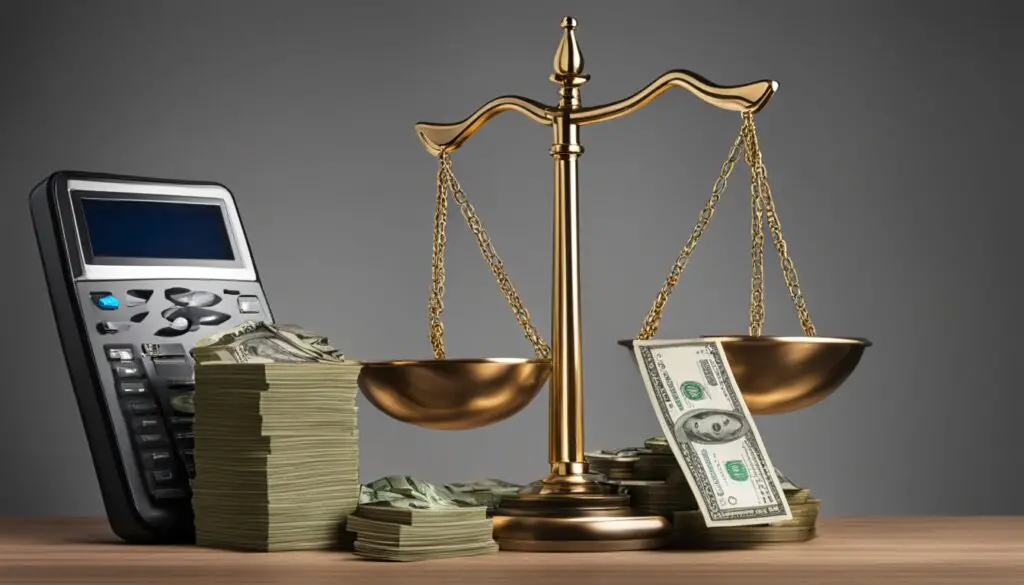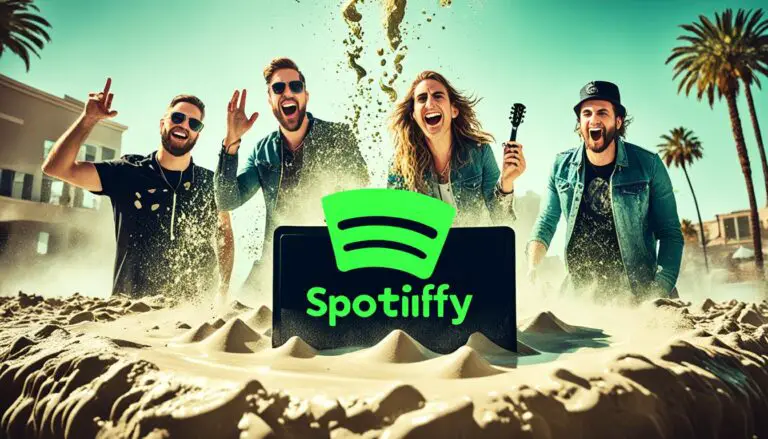A recent UK study highlights a big issue for musicians today. It reveals that most plays on Spotify are from user-made playlists. Many worry that Spotify doesn’t pay artists enough. This has led to calls for fair pay and a better music world for all.
Damon Krukowski, a musician, thinks Spotify favours the big stars. This makes it hard for new artists to earn a living. The Union of Musicians and Allied Workers (UMAW) wants Spotify to raise its payment to £0.01 per play. Right now, they pay an average of £0.003. Spotify says it pays rights holders based on how many times songs are played.
This affects more than just Spotify. A GEMA study found that almost 90% of musicians think streaming services don’t pay fairly. Many believe these platforms keep too much money. Musicians also want to know more about how songs make it onto playlists. This article will dig into the issues of music pricing, its impact on artists, and ways to ensure they get paid fairly.
Key Takeaways
- Over half of Spotify playlist plays come from user-made playlists, highlighting the inequalities in the music streaming ecosystem.
- The Union of Musicians and Allied Workers (UMAW) is demanding that Spotify pay rights holders £0.01 per stream, rather than the current average of £0.003.
- Nearly 90% of musicians feel streaming services do not pay enough, and over half believe streaming platforms retain too much money.
- The music industry crisis is fueled by complex issues around music pricing and the need for more equitable music monetisation and sustainable artist income.
- Addressing the crisis requires finding solutions that ensure fair royalties for artists and a more ethical artist remuneration system.
Spotify’s Dominance and Controversy
In 2021, Spotify had 162.4 million paying users. This made up 31% of all music streaming subscribers. It was way ahead of Apple Music. Spotify’s position as the top music streaming service is clear.
But, Spotify has also had its fair share of problems. Recently, Neil Young took his music off Spotify. He was worried about Joe Rogan’s podcasts giving out wrong vaccine information. Then, Joni Mitchell did the same. Spotify plans to show warnings on podcasts that talk about COVID-19. This shows how Spotify relies heavily on special deals. They paid $200 million just for Joe Rogan’s show.
Even with these issues, Spotify leads the market. Its free, ad-supported service and the growing interest in music streaming help. This shows Spotify’s big role in the music streaming world.
The Debate Around Artist Compensation
The issue of artist pay on Spotify and other platforms has long been debated. Spotify’s way of paying artists is through a “pro-rata” model. This means artists get money relative to how many total streams they have. The problem is, this method seems to help the big stars more than the up-and-comers.
Spotify’s “Pro-Rata” Payment Model and Its Critics
The Union of Musicians and Allied Workers (UMAW) is not happy with Spotify’s pay scheme. They’ve gathered support from 30,000 musicians. Their goal is simple: they want Spotify to pay £0.01 per stream to rights holders, not the current £0.003 average. UMAW calls this system a “reverse Robin Hood scheme.” It pulls money from smaller artists and gives it to the already wealthy music stars. Spotify says it pays rights holders, not artists directly. They also argue that looking at a “per stream rate” is not the best way to understand the pay artists get.
The Union of Musicians and Allied Workers’ Demands for Fair Pay
Streaming has taken over music in the last ten years, but many artists still see little money. To make a $15 per hour minimum wage, an artist needs 800,000 monthly streams on Spotify. The issue is, new and lesser-known artists find it hard to earn from their music. Now, artists need about 3,000 streams to earn what they would from selling one album on Spotify.
| Metric | Value |
|---|---|
| Average payout per stream for artists (as of 2020) | A third of a cent |
| Monthly Spotify streams required to earn $15 per hour minimum wage | 800,000 |
| Streams required to make a single album sale on Spotify | 3,000 |
Spotify’s Business Model and Its Challenges
Understanding Spotify’s business model is key to the debate on artist compensation. The service earns money from both its Spotify subscription tier and its Spotify free tier with ads. Although the paid option brings in more cash, the free choice draws in more users.
But, this has negative effects on artist payouts. Free users often listen to various songs, which can lower an artist’s cut. Also, Spotify aims to grow its user base. Some worry this quest for market dominance might mean artists are not paid fairly.
| Spotify Premium Cost | Average Artist Payout per Stream | Monthly Streams Needed for Minimum Wage |
|---|---|---|
| $9.99 per month | Around a third of a cent | 800,000 |
The table above explains some music streaming economics affecting artists. Artists need many plays to make a decent living wage. Although the paid tier offers loads of music, the pay for each stream is quite low.

The Evolution of Music Pricing
The music industry has really changed how we buy and enjoy music. Moving from CDs to online downloads, and then to streaming, has changed the game. These days, anyone can listen to tons of music by just paying a small monthly fee.
This change is good and bad. It lets more artists and music styles get heard. But, it also means people value music less. This is tough for artists and music makers. They find it hard to make a living when most of their money comes from streaming.
From Physical Albums to Digital Downloads and Streaming
Things shifted from buying CDs to downloads, and now to streaming. This big change in how we pay for music is all thanks to streaming. Now, all music is right at our fingertips, without buying a single album or track.
The Democratization of Music Consumption
Streaming has really changed how we listen to music. It’s like a music library on your phone. You can listen to any artist, any genre, any time. But, this easy access has made music seem less valuable. People have gotten used to not paying much or nothing to listen.
| Key Metric | Statistic |
|---|---|
| Spotify’s Market Share | 32% |
| Apple Music’s Market Share | 18% |
| Streaming Contribution to U.S. Recorded Music Revenue | 84% |
| Overall Music Revenue Increase in 2020 | 9.2% |
| Spotify Royalties Paid in 2020 | Over £5 billion |
The change in how we pay for music has big effects, good and bad. It has let more people hear different music. But, it has also made music less valued. This is hard for artists trying to earn a living. They struggle in a world where most money comes from streaming.
Spotify uderpaying artists, musicians funding, music crisis
The Impact of Low Streaming Royalties on Artists and Producers
Spotify and similar platforms pay very little in streaming royalties. This hits the artists and producers hard. Independent musicians and those without major labels are finding it difficult to keep going. The music industry is facing a financial crisis because album sales are down, and streaming pay is low.
The Consumer Perspective on Music Pricing
Consumers love how streaming services make music accessible and affordable. But, this has set a trend for expecting music to be free or very cheap. This clash between what listeners want and what artists need is a big issue. It’s at the core of the music industry’s problem with pricing.
The data shows just how tough things are for artists and the music world:
- The most an artist can earn per stream on Spotify is a tiny $0.003.
- By 2024, Spotify won’t pay for about two-thirds of its songs (those that don’t hit 1,000 streams a year).
- Spotify leads the music streaming world, with more than Apple and Amazon combined.
- In the US, 84% of money from music comes from streaming.
Even as Spotify makes big profits, its pay model is seen as unfairly stingy. It pays out only $0.0038 per stream, which is less than a penny.
This has sparked a movement for better pay for artists. A petition with over 26,500 signatures calls on Spotify to raise what it pays out per stream. But, Spotify says that looking at a “per stream rate” isn’t the best way. It argues it shares the money it makes with rights holders, not just the artists directly.
The Pursuit of Growth and Its Consequences
Many music companies want to fight pricing problems and stay profitable. They do this by growing and earning money in different ways. But, this push for growth can lead to problems. Some firms use aggressive marketing tactics and make exclusive partnerships with streaming sites. These actions can cause unintended consequences.
The Case Study of Apple Music’s Pricing in Turkey
Apple Music’s pricing in Turkey is a good example. It costs 9.99 TL/Month, or 0.37 USD/month. In the U.S., it’s $9.99 USD/month. This big difference in prices shows that the music industry might be growing too fast. It tends to put growth over making prices fair, even in local markets. The situation with Apple Music in Turkey is a case in point. It shows how focusing on aggressive strategies can make the pricing issue worse and lower the value of music.

Potential Solutions to the Pricing Problem
The music industry is looking at different ways to fix its pricing issues. One idea is to mix streaming with different prices for special content or features. This approach aims to give fans choices while making sure artists are paid fairly.
Reimagining Music Pricing Models
The way music is priced needs a new look. A mix of streaming and special, paid content could work well. This model would let artists serve different fan needs and still earn enough. Fans could choose how they wish to support musicians, based on what suits their budgets best.
The Role of Regulation in Music Pricing
Rules from the government might also help solve the problem of low pay in streaming. These could make sure everyone in the music-making process gets a fair share. Such rules might set a minimum rate for each song listened to, clarify how money is shared, and demand better reports from streaming sites. Working with regulations would aim to protect creators’ rights in the music business.
The Future of the Music Industry
As the music scene changes, new trends could shape its future. Tools like artificial intelligence and algorithms might change how music is made, shared, and priced. Live shows and selling merchandise are becoming more crucial for artists’ incomes. This could change how we see and buy music.
Predicted Trends and Changes in the Music Industry
The music world is moving towards a tech-focused future. Artificial intelligence and machine learning will impact music from creation to how much it costs. Live shows and merchandise will mean more for artists, changing the value and experience of music for everyone.
How Artists and Consumers Can Adapt to These Changes
Artists must be ready to try new things and find new ways to make money. They can use digital media to reach out to fans and showcase their work. Fans can help by paying a fair price for music. This supports the artists and the industry, making sure music can thrive for everyone.
Conclusion
The music industry is having a big problem with how artists are paid. Spotify and other streaming services might not be paying them enough. This issue is all about how much money big vs. small artists get.
Spotify says they do not pay artists directly. Instead, they share money with those who own the rights to the music. But this way of doing things can really hurt smaller or newer artists.
Moving from selling CDs to downloading songs, and now streaming, has also made music seem less valuable. This has caused a struggle between making music cheap for fans and ensuring artists get paid fairly. To fix this, the music world needs to think of new ways to set prices. It should also look at rules that make sure musicians are paid well and the music world can survive.
As the music world changes, everyone needs to find a way to work together so that musicians can make a living. It’s important to fix the issue of not paying artists enough, and to find a good balance between making music affordable and giving back to its creators.
FAQ
What is the crisis facing the music industry around artist compensation?
What is Spotify’s response to the criticism of its payment model?
What are the demands of the Union of Musicians and Allied Workers (UMAW) regarding Spotify’s royalty payments?
How has the evolution of music pricing, from physical albums to streaming, impacted the industry?
How have the low streaming royalties paid by Spotify and other platforms affected the livelihoods of artists and producers?
What are some potential solutions to address the pricing problem in the music industry?
Source Links
- https://pennyfractions.ghost.io/why-majors-and-spotify-love-fake-artists/
- https://www.theguardian.com/commentisfree/2023/nov/30/spotify-smaller-artists-wrapped-indie-musicians
- https://www.thembj.org/2022/02/neil-young-vs-joe-rogan-spotifys-stance-and-its-implications-for-artists-everywhere/
- https://www.nytimes.com/2021/05/07/arts/music/streaming-music-payments.html
- https://www.latimes.com/entertainment-arts/music/story/2021-04-19/spotify-artists-royalty-rate-apple-music
- https://lasallefalconer.com/2023/02/why-spotifys-pay-structure-is-unfair-to-artists/
- https://variety.com/2023/music/opinion/spotify-new-payment-model-falls-short-emerging-artists-1235834319/
- https://davemacintyre.com/portfolio/musicians-fight-back-against-music-streaming-mammoth-spotify/
- https://releese.io/article/music-has-a-pricing-problem-the-pursuit-of-growth-is-slowing-down-the-industry/
- https://hansabbing.com/web-texts/
- https://www.talkhouse.com/on-the-future-of-the-live-music-economy/
- https://www.theatlantic.com/books/archive/2022/12/books-music-amazon-spotify-chokepoint-capitalism-review/672372/
- https://journals.law.harvard.edu/jsel/wp-content/uploads/sites/78/2020/11/Music-Paper-Final-6.pdf




Thanks for sharing. I read many of your blog posts, cool, your blog is very good.